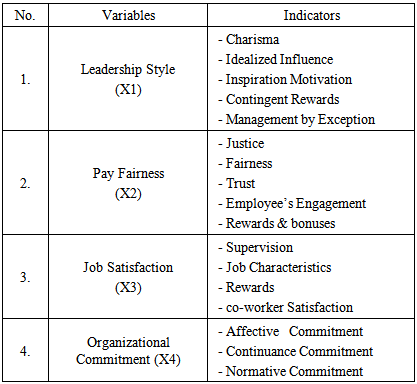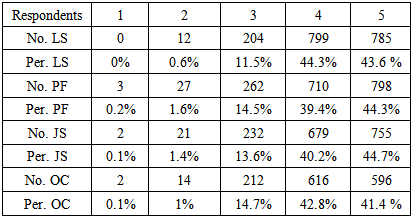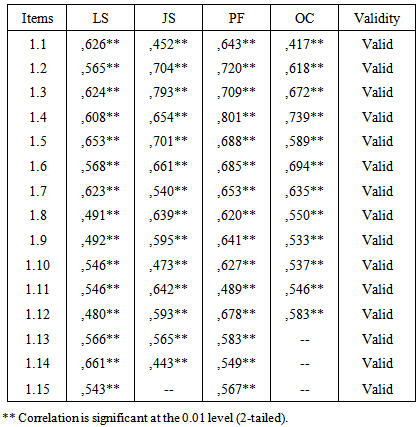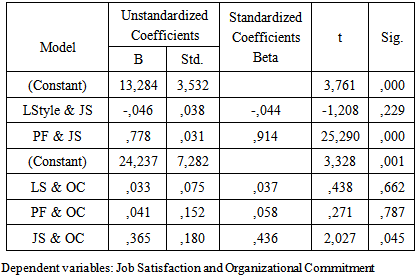-
Paper Information
- Paper Submission
-
Journal Information
- About This Journal
- Editorial Board
- Current Issue
- Archive
- Author Guidelines
- Contact Us
Management
p-ISSN: 2162-9374 e-ISSN: 2162-8416
2015; 5(2): 55-61
doi:10.5923/j.mm.20150502.05
Analysis Impact of Leadership Style and Pay Fairness on Job Satisfaction and Organizational Commitment
Abdullah M. Al-Ansi1, Kusdi Rahardjo2, Arik Prasetya2
1Master Program of Administrative Studies, Faculty of Administrative Science, University of Brawijaya, Malang, Indonesia
2Faculty of Administrative Science, University of Brawijaya, Malang, Indonesia
Correspondence to: Abdullah M. Al-Ansi, Master Program of Administrative Studies, Faculty of Administrative Science, University of Brawijaya, Malang, Indonesia.
| Email: |  |
Copyright © 2015 Scientific & Academic Publishing. All Rights Reserved.
The purpose of this research were: 1) analyzing the leadership style, pay fairness, job satisfaction and organizational commitment of Nizar Bordir Company. 2) analyzing and examining the impact of leadership style and pay fairness on job satisfaction and organizational commitment. The research type is explanatory research. The sampling technique used in this study was a proportionate random sampling. Participants in research included 120 employees selected from all departments in the company. The study adopted the descriptive method using the survey and information from the company and analyzing the impact of leadership style and pay fairness on job satisfaction and organizational commitment by using path analysis. The results of this research showed that: firstly, leadership style, pay fairness, job satisfaction and organizational commitment in the company were evaluated and described. Secondly leadership style has negative impact on both job satisfaction and organizational commitment. Thirdly, pay fairness has positive and direct effect on job satisfaction and indirect effect on organizational commitment. Lastly, job satisfaction has positive and direct effect on organizational commitment.
Keywords: Leadership Style, Pay Fairness, Job Satisfaction, Organizational Commitment
Cite this paper: Abdullah M. Al-Ansi, Kusdi Rahardjo, Arik Prasetya, Analysis Impact of Leadership Style and Pay Fairness on Job Satisfaction and Organizational Commitment, Management, Vol. 5 No. 2, 2015, pp. 55-61. doi: 10.5923/j.mm.20150502.05.
Article Outline
1. Introduction
- Leadership style and pay fairness are important determinations of job satisfaction and organizational commitment. Prior studies concluded that leadership style and pay fairness effect job satisfaction and organizational commitment.Several previous studies investigated the effect of leadership style on job satisfaction. The results of previous studies from different countries show that different styles of leadership do not have the same impact on job satisfaction Stogdill, (1970). Based on the Stogdill’s (1970) initiating structure, leadership style is more likely to provide greater commitment and job satisfaction in Asian firms, whereas in Western context consideration leadership style would provide greater job satisfaction. However previous studies have examined the impact of leadership styles on employee job satisfaction in various settings such as healthcare, military, education and business organizations. [1]Very few papers have investigated the impact on job satisfaction of pay changes. Using British Household Panel Survey data from 1991 and 1992, Clark (1999) finds the effect of pay on job satisfaction to be totally dynamic: the negative (reference) effect of lagged pay is equal to the positive effect of current pay. Clark (1999) uses dummies for nominal and real cuts interacted with pay growth, but do not detect significant non-linearity, thus finding no evidence of loss aversion. Grund and Sliwka (2007) find that job satisfaction is positively related to both pay level and pay change using German Socio Economic Panel data from 1994 to 2002. Grund and Sliwka (2007) do not distinguish between nominal and real changes (nominal pay is used but year dummies control for price changes) and nor do they investigate nonlinearities. Relationship between leadership style and commitment has been reported in the organizational and management literature. Nyengane (2007) reported a positive relationship between leader support and commitment. Nyengane (2007) indicated that transformational leaders are able to influence employees’ organizational commitment by promoting higher levels of intrinsic value associated with creating a higher level of personal commitment on the part of the leader and followers to a common vision, mission, and organizational goals. According to Spector (1997), job satisfaction influences people’s attitude towards their jobs and various aspects of their jobs. [2] Job satisfaction is affected by personal and organizational factors, which cause an emotional reaction affecting organizational commitment (Mowday, Steers & Porter 1979). [3] The consequences of job satisfaction include better performance and a reduction in withdrawal and counter-productive behaviours (Morrison 2008). Based on these facts of previous studies, the importance of leadership style and pay fairness for leading human resource development is increasingly changing depending on rapidly change in information technologies. [4]This research focuses on these two factors of human resource which are leadership style and pay fairness. To make this research more particular, this research will describe and examine the effects of these two factors on job satisfaction and organizational commitment of Nizar Bordir Company. This research is aimed to give us a meaningful description and significant examining of the relations between (leadership style, pay fairness, job satisfaction, and organizational commitment) in this company. NIZAR BORDIR Company is one of these companies that are working in cloth’s production and marketing. This company was established in 1992 in Pasuruan, Indonesia. This company is private and running by family members. The business was originally based on a partnership with the embroidery and sewing artisans in the villages in the district Bangil. Gradually Nizar Embroidery focuses on using computerized technology because of the demands of the market. Further, the reason of choosing this company, based on the objectives of the research, is examining and analysing the leadership style, pay fairness, job satisfaction and organizational commitment of the company, Because no prior studies were conducted in this company. Another reason, as a small business, this research provides a new insights for leadership style and pay fairness in small businesses. Literature relevant to job satisfaction and organizational commitment pointed out a number of indicators which determine job satisfaction and organizational commitment. Some of these indicators are leadership style and pay fairness. Job satisfaction also considered as a mediator indicator of organizational commitment.Leadership style is defined as the pattern of behaviours that leaders display during their work with and through others (Hersey and Blanchard, 1993). [5] Miller et al. (2002) view leadership style as the pattern of interactions between leaders and subordinates. According to Hersey et al. (2000), the term “leadership style” can be interpreted as leadership behaviour with two obviously independent dimensions: task and interpersonal relationships. [6]Pay is arguably one of the most critical, if not the most critical, outcome of organizational membership for employees. Actual pay and people’s attitudes about, it is the subject of much research (Lawler & Jenkins, 1992). [7] but, over the decades, the vast majority of studies concentrated on the precursors of different kinds of pay attitudes (e.g. perceptions of pay fairness, pay satisfaction, etc.) rather than on their consequences (Heneman, 1985). [8] In addition, more research on the consequences of pay attitudes concerns the prediction of other workplace attitudes than the prediction of health and work-related behaviour outcomes.Job satisfaction is defined by Locke (1976) as “a pleasurable or positive emotional state resulting from one’s job or job experiences” (p.1300). [9] Later, Armstrong (2003) defined job satisfaction as the feelings and attitudes of people toward their job. He mentioned that if people have favourable and positive attitudes towards their job, this means job satisfaction, but if they have unfavourable and negative attitudes towards their job, this means job dissatisfaction. [10]Organizational commitment has been studied in the public, private, and non-profit sector, and more recently internationally. Early research focused on defining the concept and current research continues to examine organizational commitment through two popular approaches, commitment-related attitudes and commitment-related behaviours. A variety of antecedents and outcomes have been identified in the past thirty years. Meyer and Allen (1991) and Dunham et al (1994) identified three types of commitment; affective commitment, continuance commitment, and normative commitment. [11] Normative commitment is a relatively new aspect of organizational commitment having been defined by Bateman, T. & Strasser, (1984). [12] Affective commitment is defined as the emotional attachment, identification, and involvement that an employee has with its organization and goals. However, in present study organizational commitment was measured as a whole rather than measuring its three components. Thus commitment continues to be an important area for research in human resource management and the present study is an attempt to find out its relationship with determinants i.e. leadership style, pay fairness and job satisfaction in Nizar Bordir Company.Conceptual framework: As discussed above, previous studies regarded leadership style and pay fairness as indicators for job satisfaction and organizational commitment but they didn’t explain the relationship among these variables specifically. Also, there was no study to examine job satisfaction as a pathway to connect those indicators to organizational commitment. Below are proposed hypotheses of this research.H (1): There is a significant and meaningful correlation between leadership styles and job satisfaction.H (2): leadership style has significant effect to organizational commitment.H (3): pay fairness relates significantly and positively to job satisfaction.H (4): Pay Fairness has significant and positive effect to organizational commitment.H (5): Job satisfaction relates significantly and positively to organizational commitment.
 | Figure 1. Conceptual Framework |
2. Research Method
2.1. Study Object
- Populations in this research are the employees of Nizar Bordir Company. The workforce encompasses 520 employees. Time of work is approximately 8 hours for regular employees while others who are working for part time is unknown. (47) Of participant were males, around 40% of participants. (73) of employees were females, around 60% of participants. (66) of participants were working for part time, almost 55% of participants. (54) of employees were working full time, almost 45% of participants. Nizar Embroidery is the art of embroidery Handicraft Company’s Muslim fashion. It was established since 1992, which is in Bangil - Pasuruan. The business was originally based on a partnership with the embroidery and sewing artisans in the villages in the district Bangil. Gradually Nizar embroidery Embroidery focus on using computerized technology because of the demands of the market. Results Nizar Embroidery products such as clothes and koko piety that uses cotton, because company believes these are the best ingredients in the world. By combining the art of hand embroidery (handmade) with embroidery computer system that we use is obtained quality embroidery art.NIZAR BORDIR also aspires to be a model Islamic business, by applying sacred Islamic values to a contemporary, multinational company. They follow fair trade and ethical labour practices, pursue a path of perfection by producing clothing of the highest standards, and apply Islamic financial and investment principles, avoiding interest-based financing.
2.2. Research Approach
- Research type is explanatory research. To test the hypotheses, a quantitative study of company’s employees was conducted using convenience sample of 120 among 520 employees of Nizar Bordir Company. The questions of survey were separated into four forms related to each one of the subjects. Also other data was collected such as demographic and other information data of the study participants. To successfully conduct the research, stratified proportionate random sampling procedure was used. Stratified random sampling, according to Babbie (2013), is a modification of random sampling in which you divide the whole population into two or more strata based on one or more attributes. Sample was almost 23% of population. Employees were from 4 departments (production, sales, management and designing & promotion) participated in this study.
2.3. Research Instruments
- There are 17 indicators were chosen to measure leadership style, pay fairness, job satisfaction and commitment to the company. These indicators included 56 items prepared to describe the leadership style, pay fairness, job satisfaction and organizational commitment in Nizar Bordir Company. Also, survey included three or more items related to each one of the indicators in questionnaires down.
2.3.1. Leadership Questionnaire
- Questionnaire included 15 items; these items explain many traits of leaders and their behaviours such as: Communicates effectively with others, Discerning and insightful, Believes in oneself and one’s ability, Shows kindness and warmth, Shows tolerance, is tactful and Is consistent and reliable, Is authentic, inspires confidence, Understands others, identifies with Others, Taking risks and initiate action, Providing structure and organization to work or to teams, Encouraging and showing support for others, Recognizing and valuing other, finding practical solutions. Leader is as an energetic person, Sensing and understanding people’s needs or motivations.
2.3.2. Pay Fairness Questionnaire
- Questionnaire included 14 items. Employees and other workers were asked not only satisfaction of pay, but also about trust, understanding, fairness and their engagement in decision making especially about their environment and needs. Some of the other questions like, proud to work of working in this company; company is concerned with the long term welfare of the employees, satisfaction with the training provided for my current job, immediate superior deals with employees problems fairly, there is adequate opportunity for employees to move to a better job, company recognizes the accomplishment of employees, company has adequate safety & health standard, prize from work if well done, Health insurance with family, Superior recognizing performance, The way the company treats all employees, salary Relative to the rest of the staff.
2.3.3. Job Satisfaction Questionnaire
- This questionnaire has 15 items explaining the status of the employees and workers about job and satisfaction in this job. These items include: Salary, Frequency and amount of bonuses, Connection between pay and performance, Flexibility of work hours, Opportunity for advancement, Ability to influence decisions that affect you, Opportunity to use new technologies, Communication with your supervisor, Recognition received from your supervisor, Your supervisor's management capabilities, Your overall relationship with your supervisor, Your relationship with your peers, Your relationship with customers/clients/end users, Your understanding of the business mission, Your overall satisfaction with your company, Overall satisfaction with your job.
|
2.3.4. Organizational Commitment Questionnaire
- This questionnaire includes 12 items. The way of choosing these items is to measure level of employee’s commitment to the company. The questionnaire includes many different types of items including: Willing to help organization be successful, talking up this organization to friends as a great organization, accepting almost any type of job assignment in order to keep working for this organization, values of employees and the organization's values are very similar. working for another organization giving same salary and more benefit will not be better for the employees, This organization really inspires the best in employees, There's much to be gained by sticking with this organization, find it difficult to agree with this organization's policies.(reversed), the employees are really care about the fate of this organization. Deciding to work for this organization was a good choice on their part, having many good friends and they feel like a family.
2.4. Data Analysis
- Data were collected by survey, interview and documentation. After performed data collection, we conducted data reduction. It defined as the process of selecting, sorting, analysing data. Data analysis technique is an attempt to find the answer of the research hypothesis. There are two methods of data analysis used in this research (Descriptive statistic and Inferential Statistic) Analysis. Descriptive statistical analysis in this research described the data for each indicator that used to measure latent variables. Inferential statistical analysis used two methods (Regression and Path) analysis.
3. Result and Discussion
3.1. Descriptive Statistics
- Numbers in table 2 are (1) Strongly Disagree, (2) Disagree, (3) Natural, (4) Agree, and (5) Strongly Agree. Total Mean of leadership style indicators was 4.3094 of 5 which means there is effective leadership in Nizar Bordir Company and reflects the employee’s satisfaction of their leadership style. Total Mean of pay fairness indicators was 4.2627 of 5 that showing how the employees are satisfied in the company. Total Mean of job satisfaction was 4.2881of 5 showing how the employees are satisfied of their jobs in the company. Total Mean of organizational commitment was 4.2430 of 5 which mean there is a high organizational commitment in the company. Contributing of participants opinions are shown in table 2.
|
3.2. Reliability and validity
- Nunally's (1978) "what a satisfactory level of reliability is depends on how a measure is being used. In the early stages of research . . . one saves time and energy by working with instruments that have only modest reliability, for which purpose reliabilities of .70 or higher will suffice. Based on this, reliability in this research was: leadership style .855, pay fairness .899, job satisfaction .866 and organizational commitment .748. These results showed that all variables were high reliable. Validity of all items used in this research are shown it table 3. All the indicators used in this research are valid. The amount of the acceptable value for the validity is above 3. All the values in table 3 are more than 3 which show good and acceptable values.
|
3.3. Regression Analysis
- The adjusted R-squared coefficient for this multi-variant regression model (leadership style, pay fairness and job satisfaction) is 0.857, meaning that 85.7% of job satisfaction variation is explained by leadership style and pay fairness. Standardized coefficient (Beta) of leadership style on job satisfaction is negative (Beta = -.044) and insignificant (P =, 229 >, 05). Effect of pay fairness on job satisfaction is high and positive (Beta = .914) and significant with (P < 0.01). The adjusted R-squared coefficient for this multi-variant regression model (leadership style, pay fairness, job satisfaction and organizational commitment) is 0.231; meaning that 23.1% of organizational commitment variation is explained by leadership style, pay fairness and job satisfaction. Standardized coefficient (Beta) of leadership style on organizational commitment was very low (Beta = .037) and insignificant (P =, 662 > .05). Effect of pay fairness on organizational commitment also was low (Beta = .058) and insignificant (P = .787 > .05). Effect of job satisfaction on organizational commitment was positive (Beta = .436) and significant (P < .045 < .05).
|
3.4. Path Analysis
- Two separate multiple regression analyses were conducted to test the study hypotheses. The first hypothesis was tested using multiple regression analysis with job satisfaction as a dependent variable and leadership style with pay fairness as independent variables. The second hypothesis also was tested using multiple regression analysis with organizational commitment as a dependent variable and leadership style, pay fairness with job satisfaction as independent variables.The path coefficients for the full model (with all the arrows) are derived from a series of “layered” multiple regression analysis. For each multiple regression, the criterion is the variable in the box (all boxes after leftmost layer) and the predictors are the variables that have arrows leading to the box.For the full model above, we used two layers of multiple regressions:1. with (JS) as the criterion and LS & PF as the predictors.2. with (OC) as the criterion and LS, PF and JS as the predictors.
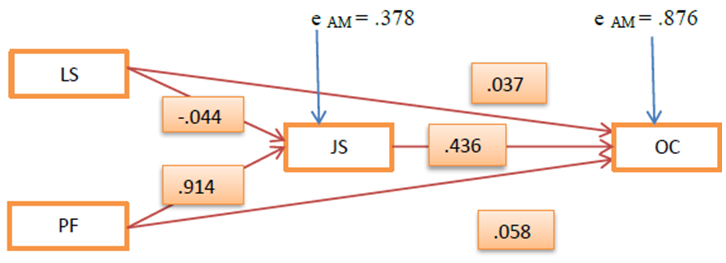 | Figure 2. Path Analyses (Full Model) |
 Examining this model we would note: 1) Leadership style has negative effect on job satisfaction, 2) Pay fairness has a strongly positive impact on job satisfaction, 3) Job satisfaction influence organizational commitment, 4) Pay fairness has no direct effect upon organizational commitment, but has indirect effect through job satisfaction and 5) Leadership style has no effect upon organizational commitment.-Test Hypothesis of ResearchThe last and important result about the impact of these hypothesizes as following:•No direct or indirect effect of leadership style on both job satisfaction and organizational commitment.•Direct, very high positive impact of pay fairness on job satisfaction. Indirect impact on organizational commitment.•Direct moderate impact of job satisfaction on commitment of the organization.
Examining this model we would note: 1) Leadership style has negative effect on job satisfaction, 2) Pay fairness has a strongly positive impact on job satisfaction, 3) Job satisfaction influence organizational commitment, 4) Pay fairness has no direct effect upon organizational commitment, but has indirect effect through job satisfaction and 5) Leadership style has no effect upon organizational commitment.-Test Hypothesis of ResearchThe last and important result about the impact of these hypothesizes as following:•No direct or indirect effect of leadership style on both job satisfaction and organizational commitment.•Direct, very high positive impact of pay fairness on job satisfaction. Indirect impact on organizational commitment.•Direct moderate impact of job satisfaction on commitment of the organization.3.5. Discussion
- Inferential statistical analysis based on the regression and path analysis examined the effect of leadership style and pay fairness on job satisfaction. The effect of leadership style, pay fairness and job satisfaction on organizational commitment was examined as well. Firstly, correlation between leadership style with job satisfaction was negative r = -.269 while correlation between pay fairness with job satisfaction was very high and positive with r = .925. Secondly, correlation between leadership style with organizational commitment (r = -.095) low negative, while correlation between pay fairness with organizational commitment was moderate positive (r = .452). Lastly, correlation between job satisfaction and organizational commitment was moderate positive with (r = .479). By using path analysis, the effect of leadership style on job satisfaction was insignificant and negative with (-, 044). Result showed high effecting of pay fairness on job satisfaction (, 914). Leadership style has insignificant effect on organizational commitment (, 037). Pay fairness has indirect significant effect on organizational commitment but insignificant direct effect with (, 058). Job satisfaction also has a high and positive effect on organizational commitment (, 436) and significant with P < .05. Result of negative correlation in this research related to some reasons. According to the related company, the negative relation between leadership style with job satisfaction and organizational commitment refers to workplace. Workplace in the related company is divided to different places and many of them are working in their own homes. On the other hand, there was very high correlation between pay fairness with job satisfaction. Employees’ Satisfaction came from fairness in pay.
4. Conclusions
- Nizar Bordir Company has suitable leadership style. Employees of Nizar Bordir Company were satisfied of pay and job. Based on their satisfaction, high commitment to the company was observed. The effect of leadership styles on job satisfaction and organizational commitment was negative and insignificant. Because, near to half of employees are working in their own homes, so this may be show there is no effective role for leadership. Direct and positive impact of pay fairness on job satisfaction can also cover the other problems of leadership style. Indirect impact of pay fairness on organizational commitment through job satisfaction can be noticed. Job satisfaction leads to high and direct positive impact on organizational commitment.
5. Recommendations
- The Results of negative correlation between leadership style and organizational commitment suggest that leaders or top management which involve ignoring problems or waiting for problems to become serious before taking action. Findings for organizational commitment explain that leaders and top management of Nizar border have to build trust, inspire a shared vision, encourage creativity, emphasize development, recognize accomplishments and bring new communication with employees of this company to make effective leadership style and create good communication between leaders (owners) with all employees. Nizar Bordir Company also need for extra space in workplace. This space will help to share opinions, expertise and receive suitable training.
ACKNOWLEDGEMENTS
- The author wishes to thank all who supported him during this research.
 Abstract
Abstract Reference
Reference Full-Text PDF
Full-Text PDF Full-text HTML
Full-text HTML